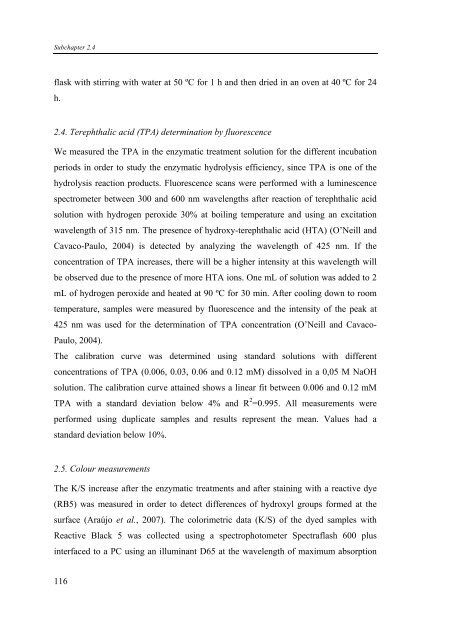Surface Modification of Cellulose Acetate with Cutinase and ...
Surface Modification of Cellulose Acetate with Cutinase and ...
Surface Modification of Cellulose Acetate with Cutinase and ...
You also want an ePaper? Increase the reach of your titles
YUMPU automatically turns print PDFs into web optimized ePapers that Google loves.
Subchapter 2.4<br />
flask <strong>with</strong> stirring <strong>with</strong> water at 50 ºC for 1 h <strong>and</strong> then dried in an oven at 40 ºC for 24<br />
h.<br />
2.4. Terephthalic acid (TPA) determination by fluorescence<br />
We measured the TPA in the enzymatic treatment solution for the different incubation<br />
periods in order to study the enzymatic hydrolysis efficiency, since TPA is one <strong>of</strong> the<br />
hydrolysis reaction products. Fluorescence scans were performed <strong>with</strong> a luminescence<br />
spectrometer between 300 <strong>and</strong> 600 nm wavelengths after reaction <strong>of</strong> terephthalic acid<br />
solution <strong>with</strong> hydrogen peroxide 30% at boiling temperature <strong>and</strong> using an excitation<br />
wavelength <strong>of</strong> 315 nm. The presence <strong>of</strong> hydroxy-terephthalic acid (HTA) (O’Neill <strong>and</strong><br />
Cavaco-Paulo, 2004) is detected by analyzing the wavelength <strong>of</strong> 425 nm. If the<br />
concentration <strong>of</strong> TPA increases, there will be a higher intensity at this wavelength will<br />
be observed due to the presence <strong>of</strong> more HTA ions. One mL <strong>of</strong> solution was added to 2<br />
mL <strong>of</strong> hydrogen peroxide <strong>and</strong> heated at 90 ºC for 30 min. After cooling down to room<br />
temperature, samples were measured by fluorescence <strong>and</strong> the intensity <strong>of</strong> the peak at<br />
425 nm was used for the determination <strong>of</strong> TPA concentration (O’Neill <strong>and</strong> Cavaco-<br />
Paulo, 2004).<br />
The calibration curve was determined using st<strong>and</strong>ard solutions <strong>with</strong> different<br />
concentrations <strong>of</strong> TPA (0.006, 0.03, 0.06 <strong>and</strong> 0.12 mM) dissolved in a 0,05 M NaOH<br />
solution. The calibration curve attained shows a linear fit between 0.006 <strong>and</strong> 0.12 mM<br />
TPA <strong>with</strong> a st<strong>and</strong>ard deviation below 4% <strong>and</strong> R 2 =0.995. All measurements were<br />
performed using duplicate samples <strong>and</strong> results represent the mean. Values had a<br />
st<strong>and</strong>ard deviation below 10%.<br />
2.5. Colour measurements<br />
The K/S increase after the enzymatic treatments <strong>and</strong> after staining <strong>with</strong> a reactive dye<br />
(RB5) was measured in order to detect differences <strong>of</strong> hydroxyl groups formed at the<br />
surface (Araújo et al., 2007). The colorimetric data (K/S) <strong>of</strong> the dyed samples <strong>with</strong><br />
Reactive Black 5 was collected using a spectrophotometer Spectraflash 600 plus<br />
interfaced to a PC using an illuminant D65 at the wavelength <strong>of</strong> maximum absorption<br />
116

















